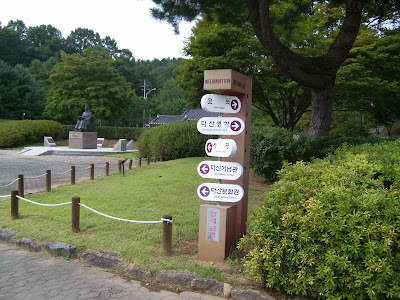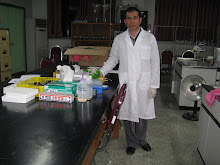ဘုရင့္ေဆြေတာ္မ်ိဳးေတာ္ေတြ ျမဳပ္နံရာ ဂူသခၤ်ိဳင္းေတြေနရာကေန ထြက္လာျပီး မၾကာခင္မွာပဲ ေန႕လည္စာစားခ်ိန္ေရာက္လာတာနဲ႕ ဒီဆိုင္ေလးမွာ အဖြဲ႕လုိက္အားေပးခဲ့လုိက္ၾကတယ္။ ငါးရွဥ့္ (장어구이)၊ အာပူရွာပူ (매운 탕)၊ ၾကက္ေကာင္လံုး (토중 닭)၊ ဘာဘီက်ဴး (생 불고기) တဲ့။ ဆရာေတြက ဆိုဂ်ဴ (Soju) ေတာ့မတိုက္ဘူးဗ်။ မယ့္ဂ်ဴ (ဘီယာ) ေတာ့တုိက္တယ္။ ေနာ္ေနာ္ကေတ့ာ ဂ်ဴ႕စ္ (Juice) ေလးပဲ အားေပးခဲ့တာပါ။ ဟဲ--ဟဲ--။ အဂၤလိပ္ေဆးသံုးေနခ်ိန္မို႕ေပ့ါ။ မဟုတ္လို႕ကေတာ့လား--ဟဲ--ဟဲ---။ ဘယ္ေနမလဲ။ 
ေနရာကသိပ္မေ၀းေတာ့ သိပ္ၾကာၾကာ ကားမစီးလုိက္ရပါဘူး။ မြန္းလြဲ တစ္နာရီခြဲေလာက္မွာ ကိုရီးယား အေတြးအေခၚပညာရွင္ ဒါဆန္း ဂၽြန္ရိပ္ေရာင္း (Dasan Jeong Yak-yong) (Korean religious philosopher) အေၾကာင္း ထိမ္းသိမ္းထားတဲ့ ယဥ္ေက်းမႈျပတိုက္ကိုေရာက္ခဲ့တယ္။ 
ဒီမွာလည္း လိုက္လည္ရွင္းလင္းေပးမဲ့ သူ (Guide) က အဆင္သင့္ပါ။ ျပတုိက္က၀န္ထမ္း ျဖစ္တဲ့ Saw Mon Su (서문수) က လုိက္လည္ ရွင္းလင္းေပးပါတယ္။ ကိုရီးယားလုိပဲရွင္းတာဆိုေတာ့ အကုန္ေတာ့ နားမလည္ခဲ့ဘူးဗ်။ ဘာသာျပန္ေပးတဲ့ PCNB က ၀န္ထမ္းေတြလည္း ေမာကုန္ၾကလို႕ ဒီေရာက္ေတာ့ တစ္ခါတစ္ေလမွပဲ ဘာသာျပန္ေပးၾကေတာ့တယ္။ ဒါက ေနာ္ေနာ္တုိ႕ကို ရွင္းလင္းေနတာေလ။ ဒါကေတာ့ အေတြးအေခၚပညာရွင္ၾကီးေပါ့။ သူ႕ရဲ့ နားေနေဆာင္ (Living Room) ေပါ့။ 
သူ႕ရဲ႕သက္တန္း ၇၅ ႏွစ္အတြင္းမွာ စာအုပ္ေပါင္း ၅၀၀ ေက်ာ္ေရးသြားခဲ့တယ္ဆိုပဲ။ ေရးဆြဲခဲ့တဲ့ သမိုင္း၀င္စိတ္ကူးပန္းခ်ိေတြကလည္း မနည္းပါပဲ။ သူနဲ႕သူ႕အစ္ကို တို႕ဟာ အေစာဆံုး Roman Catholicism အျဖစ္ေျပာင္းခဲ့သူေတြပါတဲ့။ ေနတာက နမ္ရင္ဂ်ဴ Namyangju, ဂေရာင္းဂ်ီး ျပည္နယ္မွာပါ (Gyeonggi Province)။ 
ဒါကေတာ့ သူ႕ အသံုးအေဆာင္ ေတြေလ။
ဒါေလးကေတာ့ အိမ္ရွင္မ စဖိုေဆာင္၀င္ေနတာေလ။ ျမင္ျမင္ခ်င္းေတာ့ ဘာမ်ားလုပ္ေနပါလိမ့္လို႕ထင္မိတယ္။ ဟီး--ဟီး--။ ထုိင္ေနပံုက တစ္မ်ိဳးျဖစ္ေနလို႕။ ၀တ္ရံုေတာ္ေၾကာင့္ပါ။ သူတို႕လည္း အဲဒီအခ်ိန္တုနး္ကေတာ့ ထင္းမီးသံုးတာေတြ႕ခဲ့ရတယ္ဗ်။ အခုခ်ိန္မွာေတာ့ လွ်ပ္စစ္အလွ်ံပဲသံုးႏုိင္ေနေတာ့ ထင္းမီးကို မျမင္ရေတာ့ဘူး။ အခုလို ျပတိုက္မွာမွပဲျမင္ရေတာ့တယ္။ ဒါေၾကာင့္လည္း ၾကည္ေလရာ ျမင္ေလရာ သစ္ေတာေတြခ်ည္းျဖစ္ေနတာေပါ့။ ေတာျပဳန္းစရာအေၾကာင္းမွမရွိေတာ့တာေလ။ အင္း စိတ္ကူးကေဘးေရာက္ကုန္ျပီ။ 
ဒါကေတာ့ အဲဒီအခ်ိန္တုနး္ကစိုက္ပ်ိဳးေရးလုပ္ငန္းမွာ မရွိမျဖစ္ အသံုး၀င္တဲ့ ႏြား ပါတဲ့။ ႏြားကို ေတာ္ေတာ္တန္ဘိုးထား ထိမ္းသိမ္းထားတတ္ပါတယ္တဲ့။ ဒါက သူ႕ရဲ့ဂူ ။ ဘုရင္ေတြျမွဳပ္ႏွံတဲ့ဂူေတြနဲ႕ ခပ္ဆင္ဆင္ပဲ။ ဂူထိပ္မွာ (mount) ပါတယ္။ ေက်ာက္ျပားပါတယ္။ ဒါေပမဲ့ တိရိစၦာရုပ္တုေတြေတာ့မရွိဘူး။ အမည္ေရးထုိးထားတဲ့ ေက်ာက္တိုင္ပဲေတြ႕ခဲ့ရတယ္။ 
ဒါက တစ္ေလွ်ာက္လံုး မွတ္တမ္းတင္ေပးေနတဲ့ ဓါတ္ပံုဆရာေလ။ ၾကိဳးၾကိဳးစားစားရိုက္ေနတာေလး ကၽြန္ေတာ္က တဆင့္ ရိုက္ယူလိုက္တာ။ ဒါကေတာ့ ဂူေပၚကအဆင္း လမး္ေလးဗ်။ အေပၚကေနၾကည့္ျပီး အာလိမ္ေလွကားေလးလို လုပ္ေပးထားတာေလး သေဘာၾကလုိ႕။ ေနာ္ေနာ္ကေနာက္ဆံုးမွဆင္းခဲတာေလ။ ရွင္းလင္းေပးတဲ့သူက ဟုိေရွ႕ဆံုး ေအာက္ေျခမွာေရာက္ေနျပီေလ။ 

ဒါေလးေဆြကေတာ့ သူရဲ႕ေက်ာက္ရုပ္နဲ႕ လမ္းညြန္ေလးပါ။
ဒါကေတာ့ ရွင္းလင္းေဆာင္အတြင္းမွ ပန္းခ်ီေတြပါ။ ပန္းခ်ီကအားလံုး ၈ ပံုေတာင္ရွိတာ။ သမိုင္း၀င္ပန္ခ်ီ။ တကယ့္ အျဖစ္အပ်က္ကို ပံုေဖၚထားတဲ့ပန္ခ်ီကားေတြပါတဲ့။ မထမဆံုးပံုကေတာ့ ေရျပင္ကို ျဖတ္ေက်ာ္ဘုိ႕ ေလွေတြကို ကန္႕လန္႕ခံျပီ တံတားေဆာက္ထားတဲ့ပံုပါ။ ဒီေလာက္ ေရခရီးကို ဒီလိုအစီအမံနဲ႕ ရေအာင္ခရီးသြားခဲ့တာပါတဲ့။ 
ဒီမွာ ေနတဲ့ သူ႕မိခင္က စြန္႕လႊတ္စြန္႕စားခဲ့တဲ့အတြက္ သူကိုင္တဲ့ ေတာင္ေ၀ွး ေတာင္ တစ္ေခ်ာင္းလံုး အနက္ေရာင္ေျပာင္းေနပါတယ္တဲ့။ လက္ဆစ္ေတြလည္း တုပ္ေန တယ္ေျပာတာပဲ။ ဒါကေတာ့ ဒီမွာရွိတဲ့ပန္းေတြက အရန္းလွပျပီး အထိအေတြ႕ကိုခံစားတတ္တယ္။ ကလိထိုးလွ်င္ ရားတတ္တယ္လို႕ အဆိုရွိပါတယ္ဆိုလို႕ ေက်ာင္းသူေက်ာင္းသားေတြက အပင္ကို ကလိၾကည့္ေနၾကတဲ့အထဲက ဘရာဇီးေက်ာင္းသူ တစ္ေယာက္ကလိေနတုန္း မွတ္တမ္းတင္ခဲ့လုိက္တာ။ ဒါကေတာ့ ပညာရွင္ၾကီးတီထြင္ခဲ့တဲ့ ေဆာက္လုပ္ေရးမွာသံုးတဲ့ ေက်ာက္မစက္ပါတဲ့။ သိပ္ၾကီးေလး တဲ့ ေက်ာက္တံုးေတြကို ဒီနည္းနဲ႕မ တင္ပါတယ္တဲ့။ 
ဒါေလးေတြကေတာ့ ဒီျပတုိက္ဧရီယာထဲက ျမင္ကြင္းအခ်ိဳ႔ပါ။
ဒါကေတာ့ ျပတိုက္အထဲကျမင္ကြင္းတစ္ခ်ိဳ႕။

ညေန ၃း၂၇ နာရီမွာ ကၽြန္ေတာ္တို႕ ယဥ္ေက်းမႈေလ့လာေရးခရီးစဥ္ ျပီးဆံုးျပီျဖစ္ေၾကာင္းေၾကညာပါတယ္။ မနက္က ၇း၂၇ နာရီက စတင္ရထားစီးခဲ့တာေလး သတိရလိုက္ေသးတယ္။ မိနစ္တူေနလို႕ေလ။ ညေန ၄ ခြဲေလာက္မွာ PCNB ရံုးခ်ဳပ္ကိုျပန္ေရာက္ပါတယ္။ လူစုခြဲျပီး လာလမ္းအတိုင္းျပန္ခဲ့လုိက္ရပါတယ္။ ၆း၃၅ မွာ ယုန္ဆန္ (용산) ဘူတာကေနစီးလာခဲ့ရာ ၈း၂၁ မွာ ကၽြန္ေတာ္ေနထုိင္ရာ ရယ္ဆန္ (예산) ျမိဳ႕ေလးသို႕ျပန္လည္ေရာက္ရွိခဲ့ပါတယ္။ ကၽြန္ေတာ္က အၾကမ္းမွ် ေဖၚျပေပးျခင္းျဖစ္ပါတယ္။ အေသးစိတ္သိလိုလွ်င္ ဒီမွာ ဆက္လက္ ဖတ္ရႈႏုိင္သလို ေအာက္မွာလည္း ေကာ္ပီ (Copy) ကူးေပးလုိက္ပါတယ္။ အားလံုး က်န္းမာ ေပ်ာ္ရႊင္ၾကပါေစဗ်ာ။
Jeong Yak-yong, also Jeong Yag-yong or Dasan (1762–1836), was a leading Korean religious philosopher during the Joseon Dynasty. He is commonly regarded as the greatest of the Silhak thinkers, who advocated that the formalist Neo-Confucian religious philosophy of Joseon return to practical concerns. Jeong Yag-yong and his brothers were also among the earliest Korean converts to Roman Catholicism.
Life
Jeong was born, and also ended his days, in modern-day Namyangju, Gyeonggi province.
Government service
Jeong served the government in a variety of capacities throughout his life. He supervised the construction of Hwaseong Fortress in Suwon in the early 1790s. In 1794, he served as secret royal inspector (암행어사) of Gyeonggi province, investigating misconduct by other officials. This opened his eyes to the scale of official misconduct, and may have inspired much of his later writings.
Thought
Jeong is known above all for his work in synthesizing the Neo-Confucian thought of middle Joseon. In the process, he wrote widely in fields including law, political theory, and the Confucian Classics. He sought to return Confucian scholarship to a direct connection with the original thought of Confucius. He called this return to the classics "Susa" (수사/洙泗) learning, a reference to the two rivers that flowed through Confucius' homeland.
In the service of this idea, Jeong criticized the philosophers of his time for engaging in both fruitless etymological scholarship and pursuing philosophical theory for its own sake. He argued that scholarship should be re-focused on more important concerns such as music, ritual, and law. This was not only an intellectual but a political assertion: he argued that the gwageo examinations by which people qualified for royal service should be reformed to focus on these concerns.
Names
At different times in his life, Jeong adopted a wide variety of ho, or pen names. The most well-known of these, Dasan, means "tea mountain." Jeong adopted it while in internal exile near a mountain of the same name, in Gangjin County, on the coast of South Jeolla province. Other pen names of his include Sammi (삼미/三眉), Yeoyudang (여유당/與猶堂), Saam (사암/俟菴), Jahadoin (자하도인/紫霞道人), Tagong (탁옹/籜翁), Taesu (태수/苔叟), Munamirin (문암일인/門巖逸人), and Cheolmasancho (철마산초/鐵馬山樵).
At birth, his father gave Jeong the courtesy name Gwinong, (귀농/歸農), which means "returning to the land." This reflected his father's decision to leave government service in the wake of King Yeongjo's murder of the crown prince. As a Roman Catholic, he received the baptismal name John, or 요한 (Yohan), in Korean.
After his death, the King bestowed on Jeong the posthumous name Mundo (문도/文度). Mun refers to writing or literature, and do to law.
Monday, September 28, 2009
Korea Culture Tour ဒုတိယပိုင္း
Subscribe to:
Post Comments (Atom)











































0 comments:
Post a Comment